The FAWSL continues into its second week with another mouth-watering clash between two iconic teams in the league. Manchester United take on Arsenal in what is always an electrifying battle between the two giants of English football. Manchester United had previously faced Manchester City in the Manchester derby with United losing 1-0 to a worthy match-winning goal from Caroline Weir. The statistics weren’t kind with United only having 37% possession and two shots on target. The task against Arsenal wasn’t any easier and they knew they would need to dig deep and produce a dogged display to get something out of the game.
Arsenal, on the other hand, come into the game with a perfect record having beaten West Ham and Fiorentina in two convincing displays and face Manchester United as heavy favourites. This tactical analysis will outline the tactics used by both managers to claim three important points in the WSL.
Lineups & Squads
Both teams played relatively attacking line-ups with notable absentees for both sides. Manchester United lined up in their familiar 4-3-3 transforming into a low block 4-4-2 formation looking to defend deep.
Arsenal made one change from their UEFA Women’s Champions League match against Fiorentina last Thursday. Jordan Nobbs received her first start to the season after making a comeback from a long term knee injury over the last couple of weeks. This is her first start since November 2018. Danielle van de Donk was relegated to the substitutes bench.
Manchester United had two changes of their own with summer signing Jackie Groenen and Lotta Okvist both missing due to injury.
“Unfortunately Lotta suffered concussion in training over the weekend so will not be involved in tonight’s game for obvious reasons. Jackie picked up a knock last weekend in the derby and is also unavailable for us.” – Casey Stone, Manchester United Women’s Manager
Manchester United: Earps; Smith, McManus, M Turner, A Turner; Galton, Zelem (c), Ladd, Toone; Sigsworth, Ross.
Arsenal: Zinsberger; Maier, Williamson, Beattie, McCabe; Roord, Nobbs, Little, Evans; Miedema, Mead.
Arsenal’s attacking struggle
Both teams looked to attack whilst trying to keep a compact back line. Arsenal began with the majority of possession, looking to utilise their nimble-footed midfielders in Kim Little and Nobbs. Nobbs played as the number 10 giving Arsenal much needed impetus going forward, exchanging neat passes with Little throughout much of the first half. However, Manchester United made a good account of themselves by acquitting a compact, low block shape out of possession. Their midfield bank of four looked to move together and looked to quickly close the gap to their defensive line as Arsenal moved possession forward.
“We basically just told the players that they’ve got to get out of each other’s lines. We felt that the player on the ball was always playing along the lines of others. We needed to open up the passing lines to go beyond instead of just keeping it low. – Joe Montemurro
Manchester United played with a narrow, flat midfield four that looked to drop deep when Arsenal were in possession in the final third. Having the two wide midfielders come in centrally stopped Nobbs, Little, and Miedema from combining and creating passing triangles within the Manchester United half.
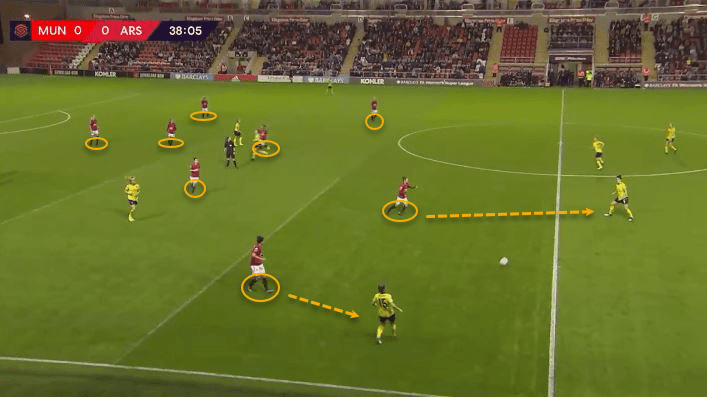
Based on the analysis, the graphic above shows, Arsenal were restricted to passing the ball around their back four patiently trying to find a way through. Katie Zelem dropped into a defensive midfield position while the two strikers adjusted their positions based on the ball’s trajectory and position on the pitch. Arsenal were frustrated by this as their first shot on target only came in the 36th minute. Manchester United were looking successful for the most part.
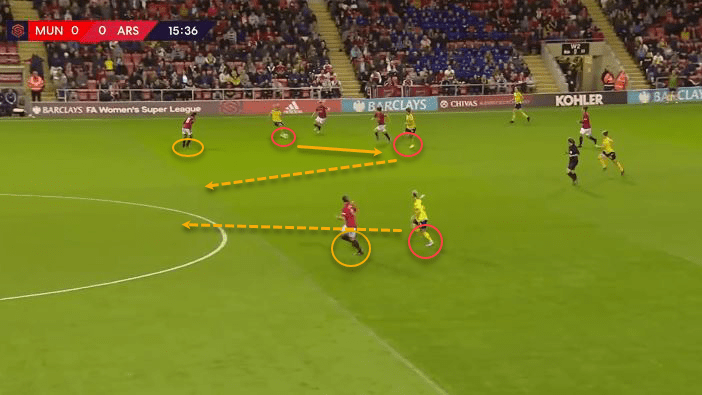
The above example shows Arsenal transitioning from defence to attack in a swift counter-attack with Manchester United caught slightly out of position. However, what the Red Devils did well in the first half was quickly get back into position. This first image shows Arsenal using the third man concept with the three players in view. Manchester United have two defenders running back to cover the unoccupied areas.
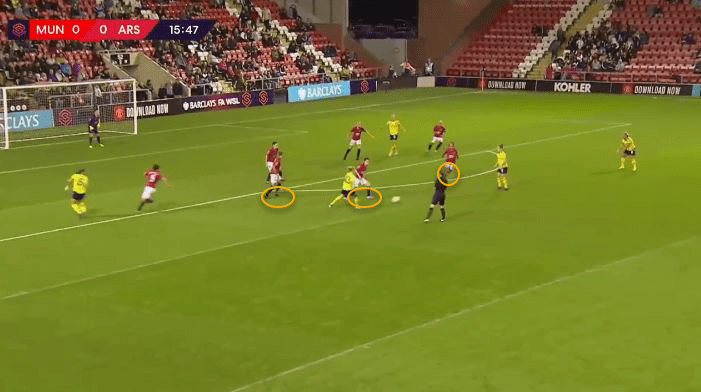
The second image exemplifies Manchester United’s willingness and tactical intelligence. They got enough numbers back into a defensive position to stop Arsenal from being able to penetrate through the centre forcing them wide. A by-product allowed for more reinforcements to arrive and give them added protection.
Arsenal’s struggle to get wide players involved
Arsenal may taken home three points, but their win was hard to come by. While we’ve seen how Manchester United effectively stopped Arsenal’s creative players from penetrating the central areas, they still weren’t efficient in bringing their wide players into play. Stone looked to implement a number of tactical strategies to repel Arsenal’s attack. One tactical plan was to create numerical superiority in the wide areas to keep Arsenal out by bringing in the attacking players into defensive situations.
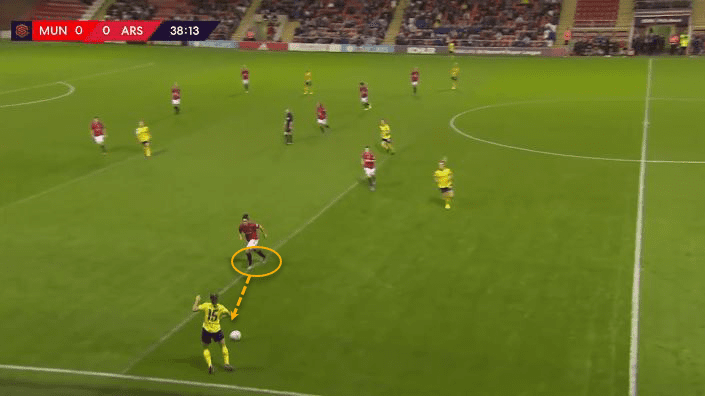
While Jessica Sigsworth was deployed further forward on the right, she was often seen dropping into a right midfield position when Manchester United were out of possession. As the above graphic illustrates Sigsworth was consistently seen moving to a right-back position to try containing McCabe and offering Turner further protection. Against Manchester City she engaged in 20 duels and winning 10, showing her willingness to track back and work hard to protect her right-back.
This allowed Hayley Ladd to move infield whilst giving Amy Turner protection against Katie McCabe and Beth Mead. Mead is tricky and looked to have flashes of brilliance throughout the game so keeping her quiet was key for Manchester United.
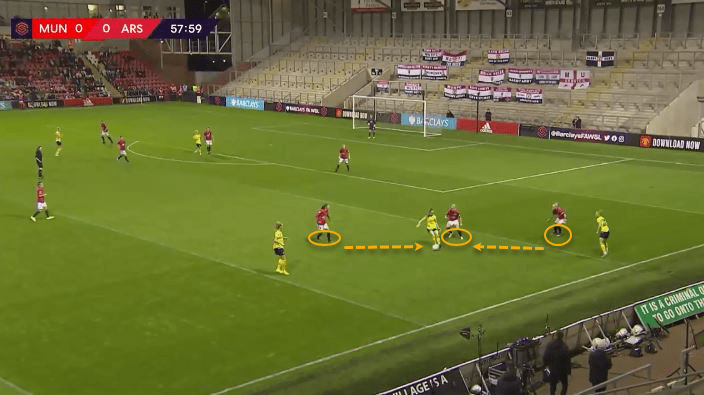
This image shows us how Manchester United looked to press and create numerical superiority against any Arsenal player that was in possession in the wide areas. All three Manchester United players were looking to close in on the Arsenal attacker and force her back towards their own goal.
Pockets of space
Van de Donk’s introduction brought about a change in Arsenal’s play and she proved to be the match winner for the WSL champions. Nobbs’ return to the starting line-up didn’t go as well as everyone had expected and will need time to get up to speed after such a long injury lay-off. Zelem was critical as she was tasked with patrolling the defensive midfield and kept Nobbs from exerting her usual influence.
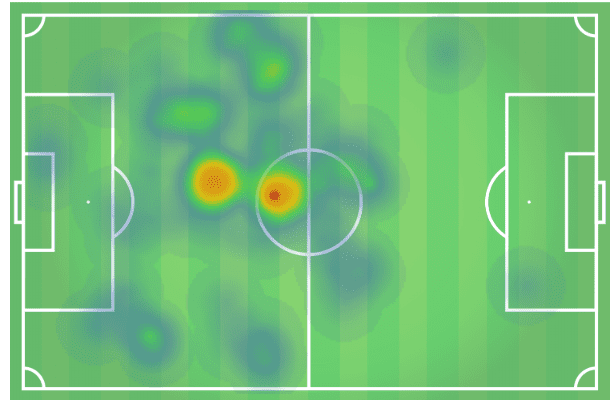
As the above heat map shows, Zelem’s average position is just under the centre circle, stopping attacking midfielders from pushing forward. Having a player that maintains discipline and doesn’t stray away from her role is important in any team.
As the game moved into the final 15 minutes, Manchester United’s energy and concentration levels were bound to drop as fatigue set in and this gave Van de Donk the platform to try and exert pressure on Manchester United’s defensive line. The Arsenal attacking midfielder found pockets of space near the 18-yard area and managed to constantly find space between the Manchester United defenders. Roaming this specific section of the pitch allows her to conserve her energy and make numerous smaller sprints to take advantage of defenders and catch them off guard without adequate protection from their deep-lying midfielders.
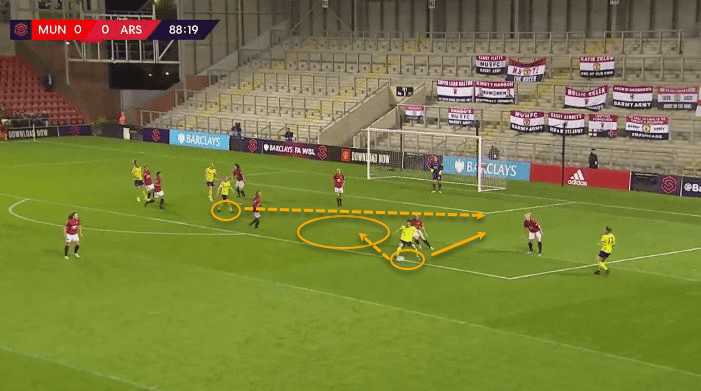
Arsenal’s only goal of the game came from some intelligent play from the Arsenal midfielder. Van de Donk identified gaps between the opposition’s defences to exploit. As this image exemplifies, the Dutch midfielder wants to drive into the marked space but has to find a way through the Manchester United defender that is tightly marking her.
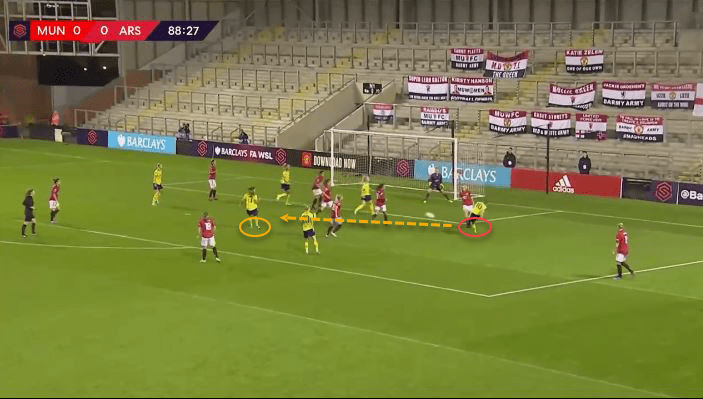
Van de Donk manages to find a way to play in Little and find space in a crowded penalty area to get on the end of the return cross. Not a single Manchester United player is seen closing down or marking the Dutch playmaker. They are caught ball watching and trying to kick the ball into row z. This gave Arsenal a much-needed breakthrough and another three points for the season.
Conclusion
Arsenal continued their unbeaten start to the season by beating Manchester United. However, the last two games have shown that Arsenal do have deficiencies against low-block, compact defences and if they are able to keep Miedema, Little, and Nobbs or Van de Donk quiet then Arsenal will need to find new solutions to scoring goals. They experimented with a three-man system against Fiorentina in the Champions League on Thursday and it looked to suit their players well. That strategy could possibly be a way forward for Montemurro and co.

If you love tactical analysis, then you’ll love the digital magazines from totalfootballanalysis.com – a guaranteed 100+ pages of pure tactical analysis covering topics from the Premier League, Serie A, La Liga, Bundesliga and many, many more. Buy your copy of the August issue for just ₤4.99 here






Comments